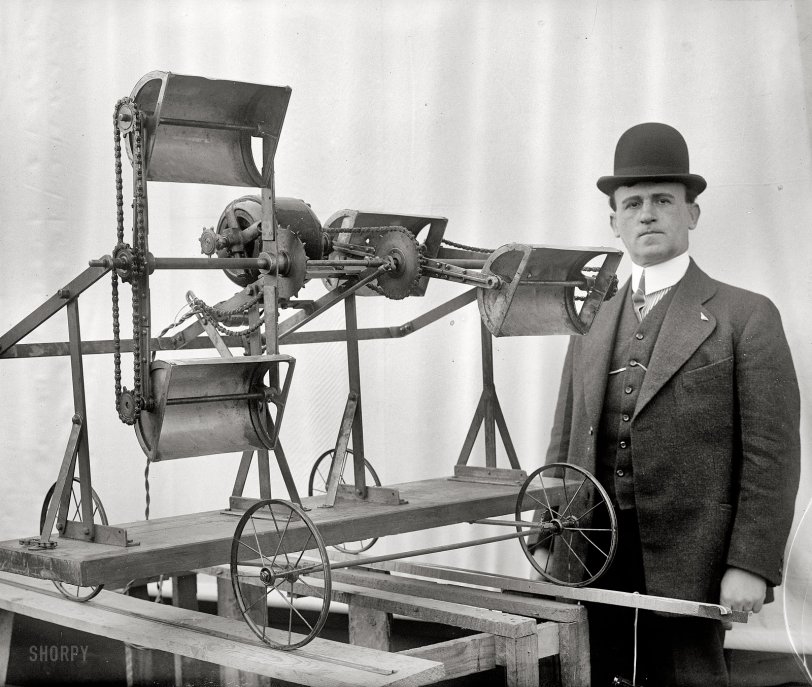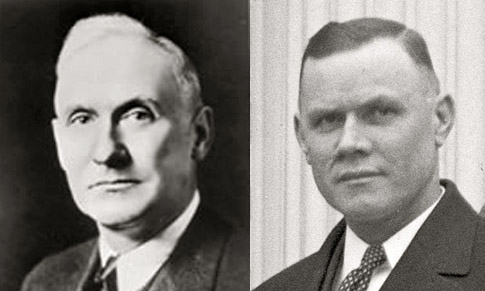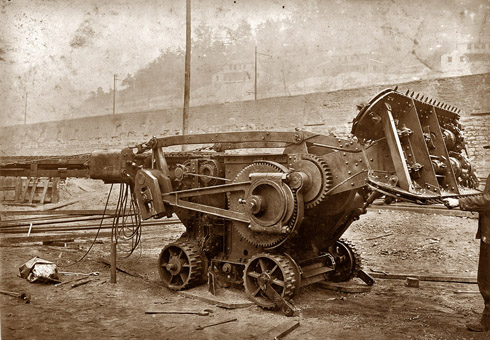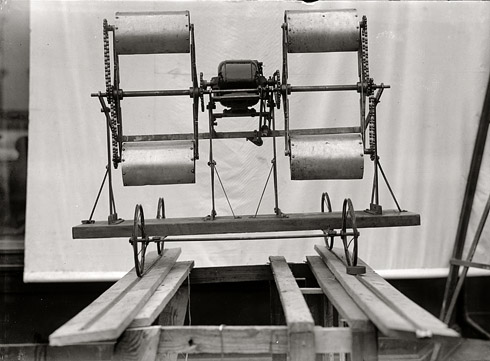


Framed or unframed, desk size to sofa size, printed by us in Arizona and Alabama since 2007. Explore now.
Shorpy is funded by you. Patreon contributors get an ad-free experience.
Learn more.

- Baldwin 62303
- Baldwin VO-1000
- Cold
- No expense spared
- Tough Guys
- Lost in Toyland
- And without gloves
- If I were a blindfolded time traveler
- Smoke Consumer Also Cooks
- Oh that stove!
- Possibly still there?
- What?!?
- $100 Reward
- Freeze Frame
- Texas Flyer wanted
- Just a Year Too Soon
- WWII -- Replacing men with women at the railroad crossing.
- Yes, Icing
- You kids drive me nuts!
- NOT An Easy Job
- I wonder
- Just add window boxes
- Icing Platform?
- Indiana Harbor Belt abides
- Freezing haze
- Corrections (for those who care)
- C&NW at Nelson
- Fallen Flags
- A dangerous job made worse
- Water Stop
Print Emporium
The Rest Is History: 1914

"Man, possibly William B. Greene, with model for a machine that appears to be designed to scoop up material." Circa 1914-1918, an inventor and invention that scarcely need introducing to anyone born in the 20th century. Harris & Ewing glass negative. View full size.
Barber-Greene
It's a bucket loader, invented by Harry H. Barber and William B. Greene. I don't know which of the two is the guy in the picture.
[I think you're onto something. Among Barber-Greene's early products were a coal conveyor and a mobile bucket loader for use in cement plants. Who are you and how'd you figure this out? - Dave]
Founding Barber-Greene
Barber-Greene was founded in 1916 by Harry Barber and William Greene, co-workers at Stephens-Adamson, a conveyor company. Interested in embarking on a business venture of their own, the two became partners – Barber would handle product design, while Greene would be in charge of finance and business administration. The partners were interested in mechanizing small jobs "out of the shovel and wheelbarrow stage."The First Conveyor Orders
Initially, Barber and Greene operated their new company from a makeshift office in a guest room at the Barbers’ residence. They subcontracted W.S. Frazier and Co. of Aurora, Ill., to manufacture the products Barber-Greene designed. In October 1916, the partners established credit with General Electric, and ordered the supplies they would need to make their first conveyor, the "No. 1," in the Frazier workshop. Before long, the company had received an order from Lilley Coal Co. With the profits made from this order, the partners began advertising in the Retail Coalman, a Chicago-based publication. As a result, the company began to receive multiple orders, and began to grow.

Harry H. Barber, William B. Greene
The buckets always face the same way
So it must be a seed spreader. (A person pushes the device along and the seeds spill out of the openings in the side of the buckets as the buckets move gently up and down.)
What's the name
of the inventor?
[We don't know. At least not yet. - Dave]
Sing along now...
It went "zip" when it moved
and "pop" when it stopped
and "whirrr" when is stood still
I never knew just what it was
and I guess I never will
Ummm, no.
You're grasping at straws.
[Below, an electrically powered excavator. The coal is carried to the left along the conveyor belt on top and dumped or dropped or shoveled into coal cars or buckets, which are on a track. - Dave]

Beating a dead horse
No, I'm not confusing anything about the terminology. This "conveyor" that you are imagining this thing to be, if it runs behind the excavator, as you claim, only conveys material that is sitting on top of the rails. There is a huge gap between the rails that is left untouched. Nothing is conveyed between the rails. This is the issue I have with the explanation being given.
[The excavator fills the buckets of the conveyor from above. The coal is not "sitting on top of the rails." - Dave]
Ok but...
This will be my last comment because I'm obviously not understanding the explanation that you seem so sure of.
There is a large gap between the 2 buckets. If this is the design then it would only scoop coal or ore off the two sides and leave a large gap in the center. Unless I'm missing something - which is always a possibility - that does not make sense.
[I think you are confusing the excavator (the machine that does the mining) with the conveyor. Which conveys -- i.e. it is designed for carrying and dumping. Not scooping. - Dave]
Maybe & Maybe Not
Some seemed convinced that this is a coal or ore conveyor designed to ride behind a coal car, but I'm not convinced. If it was meant for that task, wouldn't the scooping buckets clear a wider path than just over the rails? This design would account for a lot of waste. If that is what it is, then perhaps that is why the design failed, but I don't think so.
Since it is only scooping over the rails, perhaps it was designed to ride in front of the cars and was meant to clear debris off the rails to keep the cars from derailing. Perhaps it is (also) meant to run in front of a train to clear heavy snow off locomotive tracks.
[It would have nothing to do with railroads or trains. The conveyor travels on a track behind the excavating machine in an underground mine to get the coal or ore out of the tunnel, moving its cargo both horizontally and vertically. Or it might move along a track in an open-pit mine. Whatever it is, it looks mining-related. Designed for carrying and dumping. - Dave]
Holy buckets
The "buckets" can't be for holding anything because they are open at the sides.
Maybe the "working" side of the bucket is the outside. Perhaps it's an automated skein for winding yarn or some other textile manufacturing process.
[The buckets in this coal or ore conveyor would be closed in a working example. The near end of the bottom left bucket shows how it would look. - Dave]
Ok I don't want to give up...
Thank you for this one, it has been one of the most entertaining posts I have witnessed. You need to do more mystery objects/people often.
Another Fine Acme Product
New! Acme Little Giant Spilz-All (Pat. Pend).
Despite the helpful drawing, I'm still mystified by the orientation of the hoppers, since the very simple gearing and chain drives appear to keep them rotating to preserve the same angle (i.e. dumping only, as shown) through the full rotation around the main horizontal shaft. UNLESS the gear on each hopper is actually rotating it 360 degrees as it circles the shaft. Even with a fixed rate of rotation there might be a point in the rotational cycle in which a hopper is on the horizontal to receive loose material from one source and then, as it rises and turns, dump it onto a receiving conveyor positioned at a higher level. The device might then function as a sort of elevator from one conveyor to the next. But this still seems pretty whack, since the usual way of doing this is by ramping pairs of conveyor belts one above the other. This device may be so mysterious because the inventor offered a solution to a non-existent problem, and it never got beyond the demonstration model stage.
It's a Kluge
As the story goes, a Navy captain wanted to know every man aboard his ship and what they did. All went well until one sailor came before the Captain, gave his name, rank, and serial number followed by "Kluge maker, first class."
After some discussion among the officers, the Captain said he would certainly like to see a kluge in action. The young swabbie said he would demonstrate the next day. And sure enough, at noon sharp the sailor wheeled an ungainly object to the rail, and threw it overboard.
As it hit the surface it went "Kluge."
Obviously this is a prototype kluge.
If it was intended for use
If it was intended for use in a mine, it wasn't well designed. That motor would not last more than a day or two if that in the dust of a mine. All those friction points would be dangerous in a gaseous mine environment. And if it's a miniaturized model, full size it would be too big to operate in the tight confines of a mine.
Maybe it was a prototype that never went into production.
[As noted below, the motor would be for demonstration purposes. As for "friction points," just about any coal conveyor would have had zillions.- Dave]
Salt Water Taffy
I agree it's a taffy puller by Peter or a peter puller by Taffy.
I know what it is ...
It's a waterway power generator. An advanced form of the old-fashioned waterwheel.
Obviously.
Unless it's a power ice cream scoop.
Contraption
The machine could never be an excavator since the buckets are located in line with the wheels. Also, because of the chain arrangement, the buckets would never tilt over to dump anything. A friend of mine who has a M. E. degree says it must have been some sort of windmill. Be nice if someone could run down the patent application. At the time of this photograph, it was not necessary to have a model of an invention with the exception of those for perpetual motion machines. Maybe as has been suggested, it was intended for removing bats from mine tunnel roofs?
[No one said it was an excavator. We said it's the conveyor that follows the excavator. If the buckets were full and not in dump mode they'd be facing up, side by side. - Dave]
I am the energizer bunny of waiting Dave
I think Dave has gotten our expectations too high, and now he will not be able to deliver.
To say that anyone born in the 20th century will instantly go "oohhh...so that's who/what he/it is" may be a promise he can't keep.
Universal recognition of a piece of mining equipment, and by anyone born during anytime of a whole century?
No, sad to say, I think Dave realizes his mistake, and is delaying, hoping to wait and tire us out.
But I will be here Dave...waiting...waiting...waiting.
[Did we not read all the comments? The answer, such as it is, is down below. - Dave]
Dave cracks me up
Its his witty comments that make the difference as we ply around in the dark trying to figure out some goofy photo. Its Dave who makes it such fun. What a goof!
Scoop?
With the open sides of the buckets it doesn't seem that it would be a very efficient scooper of anything unless that which it was scooping was larger than the openings. I can't imagine what that would be. For that matter, I can't imagine what this is.
Maybe we need to think larger scale. Perhaps this is a small scale model of what is intended to be a much larger contraption. If the sides of the buckets were closed it could scoop just about anything. I think the key here is the two sets of buckets on either side. Maybe this was for a farm for digging rows for planting. Maybe it was an early ditch witch for burying power lines - a hot and a neutral.
[I'd say our 3:36 commenter pretty much nailed it. - Dave]
Drive Train
I'm still not sure of this device's intended purpose, but based on the two images, I'm pretty sure this is how it operated. Perhaps with this sketch, someone might be able to come up with the intended application.

The sketch shows the chains and sprockets in bold and the electric motor at left. The "buckets" on the end of each arm are kept synchronized in the shown position relative to the floor based on the evidence supplied by the second photo. Only one of the two arms is shown in this sketch and the "phantom" arm is provided only to show the synchronized orientation of the "buckets" as the arm rotates. The chain was intentionally disconnected in the first photo so that the arm could be manually rotated to show the construction details. The second photo show both arm aligned parallel with each other. The relationship of the buckets with respect to the floor could be varied depending on how both "bucket" sprockets were initially aligned with their sprockets on the drive shaft. Based on the small number of teeth on the motor sprocket, this was a low-speed device (less than 100 RPM). My guess is that this is a working model that was submitted along with the patent application.
Wensleydale Excavator
Quite clearly a young Wallace. But where is Gromit? He can explain everything.
What it is
Obviously (or maybe not) this is some sort of mining conveyor designed to travel on a track in the tunnel behind the excavator. The buckets are shown here in the dump position. The electric motor would be for demonstration purposes.
[I think you're on the right track. So to speak. The archive caption for these is "unidentified machine model." - Dave]
How long
are you going to keep us guessing? It's slowly driving me crazy!
Another way of looking at it
You can build this!
My first thought was an early Erector Set.
Not Scoops or Scrapers
Each pair of hoppers is facing in the same direction at all times, as controlled by the chain drives when the central shaft rotates. So it can't be intended to operate as a set of scoops for wind or water, or scrapers, or conveyor buckets. This inconvenient arrangement shot down my pet theory that the device was intended to clear roosting bats from the ceilings of railroad tunnels.
Sprockets
I've got no idea what this is, but it's never going to work as long as the crucial middle chain remains off the sprocket.
If the inventor spent less time looking fiercely proud, in his obviously used-to-ridicule way, and more time hanging all his chains, we'd have guessed what this is by now.
Generator, too
I see it as a generator, too, but a hydro-electric one. Small scale, for use in a stream, or at a small waterfall. Wheels just for display purposes?
Cannibalization
I dunno what it is, but Mrs. Inventor is going to be plenty ticked off when she finds out what's happened to their baby carriage, bicycle and coal scuttles.
My guess
A generator, perhaps wind-driven.
Car.
It's simply an automobile that moves by pushing air.
The scoops are obviously less practical than propellers, but perhaps the idea of a propeller wasn't as obvious then as now. Or the inventor was just dumb.
A flying machine
The scoops take up air at a constant aspect angle as they rotate.
Snowplow
It's a early electric snowplow. Not only did the electric cord do it in, but it didn't have anything attached to it to knock over roadside mailboxes or pile up snow at their driveway entrances.
Well of course.
It's a taffy stretcher. Am I warm?
That's Peabody, famous in West Virginia
Experimental model of a dragline or bucket conveyor.
Medical technology setback
"This well-intentioned but ill-conceived invention thwarted doctors' attempts to encourage regular colonoscopies for almost fifty years."
Following in Grandpa's Footsteps...
It's Eli Whitney the Fifth, and his Patented Gin Cottoner
You may laugh now...
...But just wait 'til you wake up to see an army of those things marching down your street!
Congressional Sanitation Device
Prototype device, designed to patrol the Congressinal aisles, scooping up massive amounts of government waste and depositing it in a trailing container for recycling. The practical Dual Scoop System permits it to work both sides of the aisle. A fleet of them were subsequently manufactured and work diligently to this day.
Road Apple Cleanup
This is a nice Electric Rolling Pooper Scooper.
This inventor would have been a household name but for the phasing out of horse-drawn carriages.
Sound effects
It's clearly a "clip-clop" sound effects machine for the movies. Unfortunately, the inventor failed to realize that talkies were still several years away.
Please, introduce us!
Well, yeah, gee that thing sure does look familiar, I had one in my backyard growing up, but even then I wasn't sure if it was to rock the baby or pick the corn or thresh the wheat. I'm sure I'll slap my forehead and feel real dumb when you tell us, but what the heck is that, if not a ferris wheel with finger-removing gearwheels?
Wow
Nicest apple peeler I've ever seen.
Obviously
"Harry Reese's early attempt at making machinery for use in combining and cupping chocolate with peanut butter."
Well of course.
It's the prototype of the machine that would eventually add two scoops of raisins to Raisin Bran. This one could do two boxes at once.
It's either
It's either inspired by monkeys at the zoo, or some form of travelling fan. Such a fan might be used in orchards on cold nights, to stop a frost settling on the fruit.
But, I'm going with the monkey device.
Back to the drawing board
"1914. George Ferris's famously unsuccessful first attempt at a carnival ride."

























On Shorpy:
Today’s Top 5